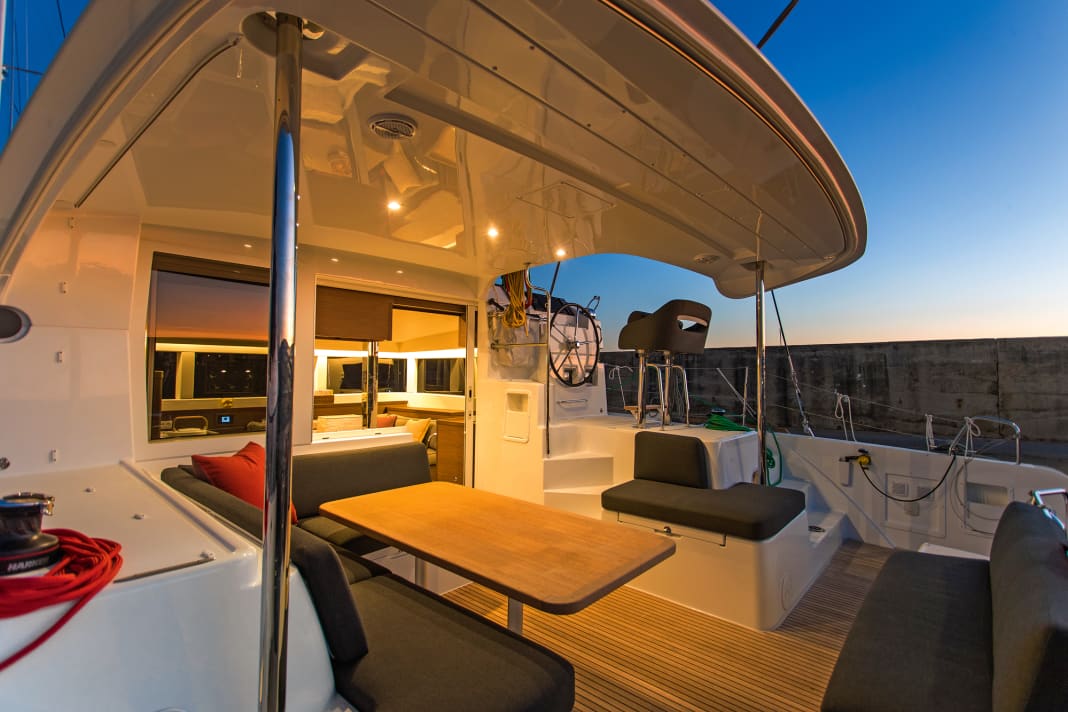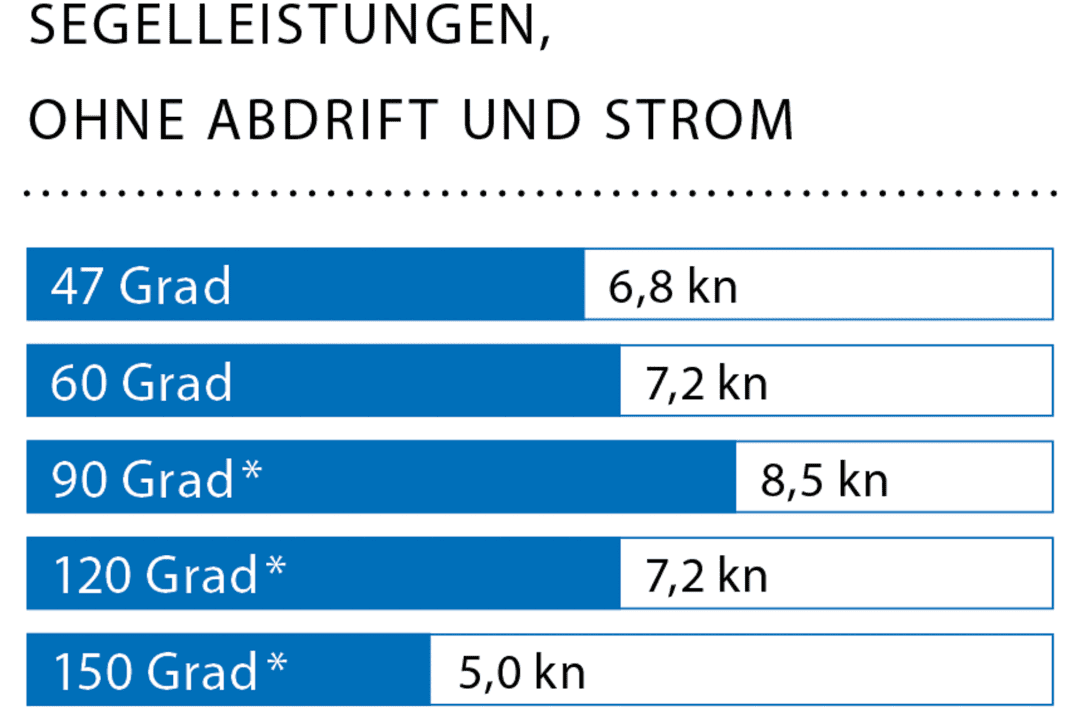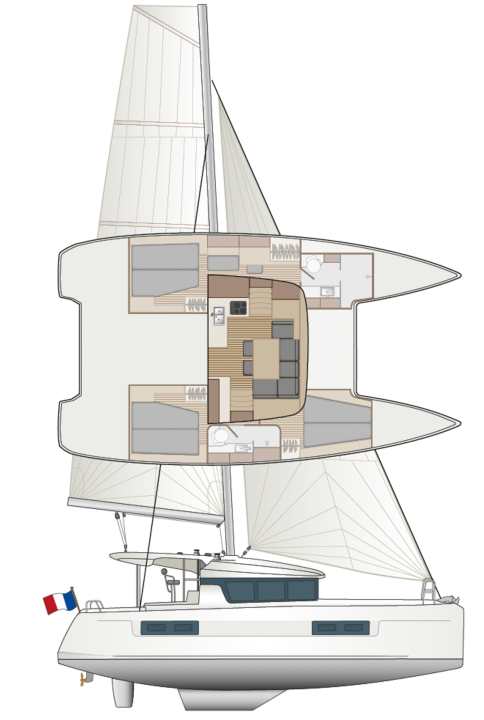





Its predecessor, the Lagoon 39, was unveiled at the end of 2012 and caused a lasting stir in the multihull scene. With the then new entry-level model, the world's largest catamaran manufacturer from Bordeaux had presented a forgotten rig concept with a mast positioned unusually far aft and a self-tacking jib as standard. That was the big innovation at the time.
And this has obviously proved very successful. All the new ships from Bordeaux have a similar sail plan, including the Lagoon 42, 50 and 52 models and, of course, the Lagoon 40.
The competition
The deck, superstructure and bimini top remain essentially unchanged. Although the shipyard has made some minor adjustments and improvements to the details, the parts are still from the same, slightly modified moulds. However, there is one significant change to the 39: the platform between the hulls has been extended aft by around one metre. This means that the 40 has more space outside, and there is a bench seat that runs right across the rear and completely across the width of the cockpit.
The two hulls, on the other hand, have been completely redesigned. These are not only more corpulent and slightly higher than their predecessor, but also come with moulded edges that extend all the way to the bow, both on the inside and outside. The chines allow the waterline to be kept narrow while at the same time increasing the volume in the hulls, thus opening up new possibilities for the expansion of the cabins. On the Lagoon 40, the floorboards can be slightly lower. This means that the headroom in all living areas has increased by around 10 centimetres compared to the Lagoon 39.
Berth size is royal
The double berths in the foredeck have also become larger, or rather even larger. Compared to its competitors, the Leopard 40 and Nautitech Open 40, the Lagoon 39 already boasted the most comfortable dimensions. In the 40, the forward berths at shoulder height are even wider at 1.56 metres, and there is now also significantly more space in the footwell.
Lagoon has changed the concept of the 39er for the aft extension. Previously, the berths were installed transversely to the direction of travel. Now the berths are once again aligned lengthways, which makes it easier to get in and creates additional space for storage compartments and shelves at the sides. With a width of 1.52 metres at the shoulders, the sleeping area here is also large enough for two and therefore somewhat more comfortable than in the previous model.
With four wet rooms
Like all comparable cats in the entry-level class with a hull length of around twelve metres, the Lagoon 40 is also available in two versions: as an owner's boat with three cabins or in a charter version with four cabins. With the Lagoon 39, there was still the option of converting both hulls into full-beam master cabins with a large wet room in the foredeck, i.e. a two-cabin version for owners only. However, due to a lack of demand, Lagoon has cancelled this option for the new ship. What is new, however, is that you can also choose between a larger bathroom with a separate shower area or two smaller toilet rooms for the two-cabin layout in one hull. This means that a maximum of four cabins with four separate bathrooms are possible. In this case, the berths in the foredeck are built further into the forepeak and are therefore somewhat smaller.
Although the mast is still in the same, far aft position, the sail area has increased with the clearly flared and almost rectangular mainsail. Only with a self-tacking jib did the Lagoon 39 prove to be somewhat underpowered in the comparison test. Its sail carrying capacity was relatively low with a value of 3.7, partly because the boat was built heavier than the cats in the competition. Now, over ten square metres more sail area on the slightly higher mast ensure increased performance, and the 40 is also around 800 kilograms lighter than its predecessor. This increases the sail carrying capacity to a value of 4.1, but still falls short of the theoretical potential of the competition.
More sails, more power
One reason for this is that although the furling Code Zero is only available as an option on the Lagoon 40, it is an essential part of the concept. The crew on the Lagoon 40 can only utilise its full performance potential when the generous additional sail is furled - especially in light winds and from 70 degrees true wind angle. The self-tacking jib still has to be used for tacking, which worked quite well in the test off Mallorca in a brisk sea breeze of around 14 knots.
With a tacking angle of around 95 degrees, the small Lagoon makes rapid progress at 6.8 knots. With half the wind and Code Zero unfurled, the log quickly reaches over 8.5 knots. In manoeuvres, the 40 shows good reactions and also turns quickly. The steering responds well, even if there is little pressure and therefore little feeling on the wheel when sailing with the jib. With Code Zero and more steam in the rig, the boat can be steered more sensitively and precisely.
It is particularly noticeable that the cat loses very little speed in the tacks with the self-tacking jib and quickly returns to its set values on the new bow. With increasing wind and swell in the test, the main advantage of the far aft rig becomes clear: due to the concentration of weight in the centre of the boat, the Lagoon shows little tendency to pitch and roll in the waves - an issue with many competitors.
Impeccable build quality for the Lagoon 40
The styling for the interior comes from Nauta Design. Contrary to the general trend towards light-coloured wood, Lagoon is fitting out its current models with a dark walnut wood as standard, and this also applies to the 40. The floors made of Asburgo, a light-coloured oak wood, contrast well with this. Together with the warm light from the predominantly indirect lighting and the thick and comfortable upholstery, the interior is elegant, pleasant and extremely cosy.
The build quality and workmanship in detail on the test boat, build number 1, are impeccable, even in the area of technical installations. However, when lying at anchor in the bay in light swell, a creaking noise somewhere in the structures of the cabin superstructure and bimini, which cannot be localised at first, is annoying. The shipyard wants to find out the cause and make improvements.
Good marks for the air circulation on board. Effective cross ventilation is possible in all living areas, in the toilet rooms and in the saloon thanks to large hatches and side windows that can be opened.
With a base price of 504,900 euros for the Kat, the competition in the important entry-level class remains intact and, with another model, more exciting than ever before.
The measured values for testing the Lagoon 40




The Lagoon 40 in detail

Technical data of the Lagoon 40
- Design engineer:VPLP Design
- CE design category:A
- Torso length:11,74 m
- Width:6,76 m
- Depth:1,35 m
- Mast height above WL:18,42 m
- Weight:10,9 t
- Mainsail:47,5 m2
- Self-tacking jib:33,8 m2
- machine (Yanmar):21 kW/29 hp
Hull and deck construction
Built in five parts. GRP sandwich in vacuum infusion process with balsa wood core. Plywood bulkheads.
Price and shipyard
Base price ex shipyard: 504,900 euros incl. 19 % VAT.
Guarantee/against osmosis: 2/5 years
As of 10/2023, how the prices shown are defined can be found here !
Shipyard
Lagoon Catamarans, Bordeaux; www.catamarans-lagoon.com
Distribution
Dealer network
YACHT review of the Lagoon 40
More than just an update: the Lagoon 40 replaces the 39 with new hulls, more living space and a fresh look. An extension with four cabins and four heads is now also possible.
Design and concept
- + Efficient rig geometry
- + Solid construction
- + Attractive pricing
Sailing performance and trim
- + Agile reactions in manoeuvres
- - Little potential with jib only
Living and finishing quality
- + Extension with up to four wet rooms
- + Larger bunks, more headroom
- + Good ventilation options
Equipment and technology
- + Self-tacking jib as standard
- + Impeccable standard of equipment
- - Code Zero only for a surcharge
This article first appeared in YACHT 07/2018 and has been updated for this online version.
More on the topic:
- Lagoon 42: Cruising catamaran from the market leader
- Lagoon 46: Cruising catamaran from France put to the test
- Converted Lagoon 50: Boat-office de luxe!
- Lagoon 51: A cruising catamaran like a sailing penthouse
- Lagoon 51: Plenty of space, even more comfort and good sailing characteristics
- Lagoon catamaran: "Seventy 7" with aerotransmitter in high demand

